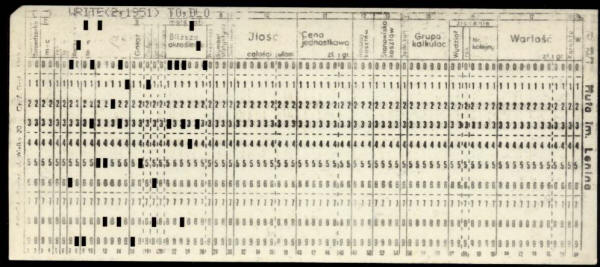Information:
Most of my cards conatin numerical data or program lines in
Fortran (some are program initialization for CDC CYBER 72
machine, which was used in Cyfronet in Cracow, another seem to
be initialization for unknown Unified System machine). Most
cards have prints suggesting that they come from Cyfronet, but
these cards were used widely in Cracow, not only in Cyfronet, as
I have about 50 blank Cyfronet cards from former Architectural
Office in Cracow. Some single cards contain "COBOL" or "FORTRAN"
remarks, but they all contain data or Fortran code. |
|
Another
interesting item I got with these cards are two printouts from
unknown computer and probably Polish Mera lineprinter (see
Russian Sh letter used for filling character in big text). They have
big, figlet-like headers with program name and version.
The first one was too damaged to be read (moisture, fungus,
water and soil), and contained printout of NURA1Q (? - even
header was unreadable) software, probably launched for or in
Jagiellonian University.
Second one seems to be complete and contains
MINUIT
numerical optimization program result, description and Fortran
source code of minimized function. Program seems to be ported to
one of Polish machines, as description is in Polish. Below you
can see first pages, the last photo is the last page. Some pages
with optimization passes are not photographed.
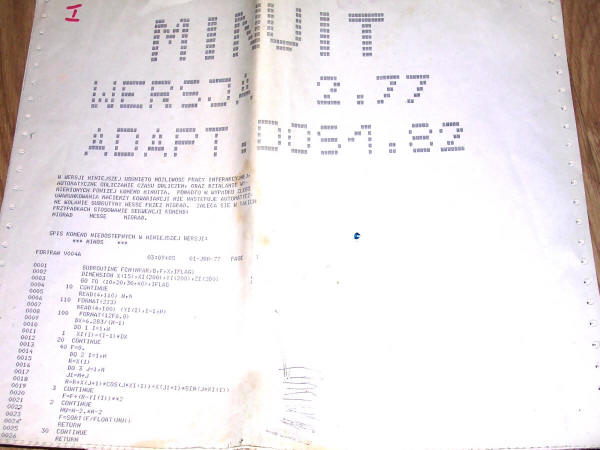
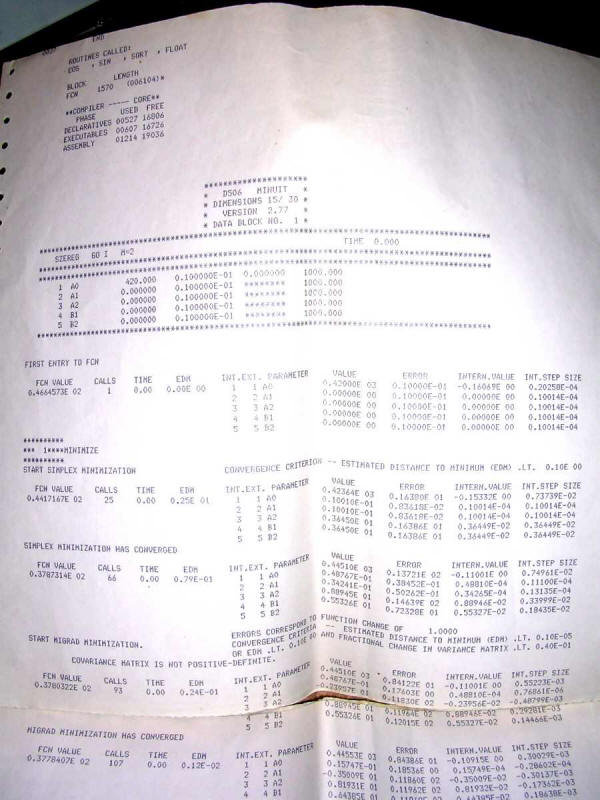
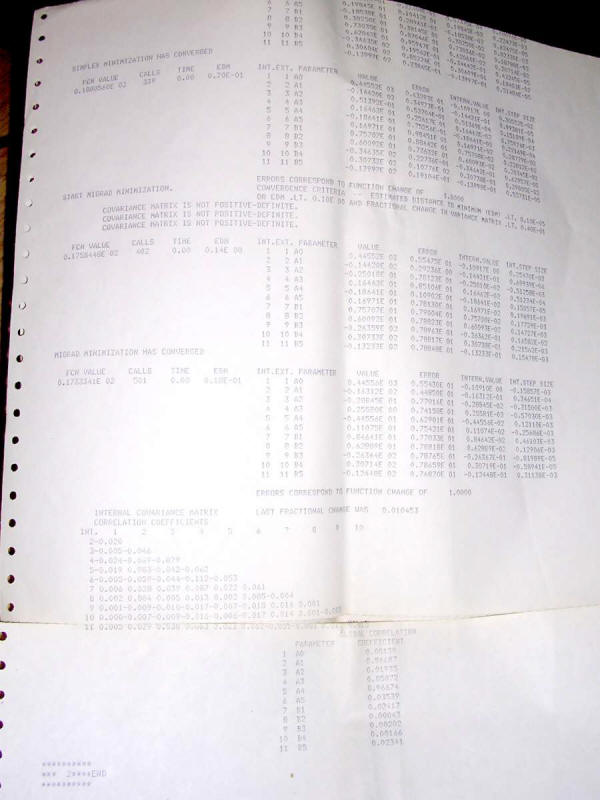 Quick translation of Polish text from printout:
MINUIT
version 2.77, Adapt. DOS1.82.
In current
version we deleted interactive processing,
automatic computing time estimation and actions performed
by listed commands. Furthermore, if covariance matrix is badly
conditioned, the HESSE subroutine is not called by MIGRAD.
In these cases it's suggested to use the following sequence of
commands:
MIGRAD HESSE
MIGRAD.
List of commands not
accessible in this version:
*** MINOS *** |
[Update: 2017-01]
| Here are two other interesting items related to
perforated cards. the first one is a complete Fortran
program made on cards, stored in a cardboard box. I
found it in my University dump. From what I understood,
it is for optimizing work parameters of steel rolling
mill. It was perforated on accessible cards, means there
are different templates printed on them, not related to
programs. Most are blank ones, some "Fortran" and
"Data". However, interesting templates are printed on
cards used for registering products in "Huta im. Lenina"
in Cracow, Poland, later "Sendzimir
Steelworks", now probably Mittal Steel (if owner
haven't changed again). You can see this template as the
last in pictures above. |
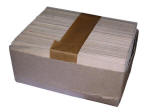 |
 |
Another interesting item is a postcard on perforated
card. I found it in old book I bought from second-hand
bookshop. The numbers side can be seen in the picture on
the left. On the other side of the card there is a full
address and validated post stamp. The recipient was
Professor from Jagiellonian University in Cracow
(unfortunately died in 2011). The postcard was sent
probably in 1986, stamp is not easily readable.
|
The text perforated and printed is:
"Pozdrowienia ze Szkoły Letniej przesyła NKI".
Translated to English: "Greetings from Summer School
from NKI". Let's figure out what is it about. Summer
School is a summer course of computer science organized
to help people interested in IT and computers learn
basics. These courses were organized in 1980s and were
quite popular among late school students who wanted to
start academic IT education easier.
Now what is NKI? The only thing linking "NKI" to
Jagiellonian University and recipient of postcard is in
History Page
of Computer Science Student's Association. NKI figures
there in late 1970s and 1980s, yet this abbreviation is
not expanded. I think it may be "Naukowe Koło
Informatyków" - Computer Science Student's Scientific
Association.
So we can see that perforated cards were not used
only to store programs and data... |
As usual, here are some photos from old books, catalogues and magazines:
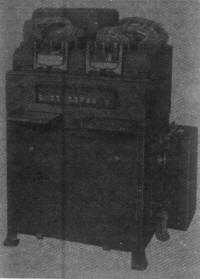 |
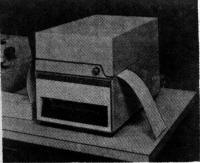 |
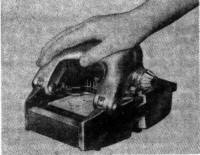 |
| Card copier |
Edge-type perforator connected to
typewriter. |
Manual perforator |
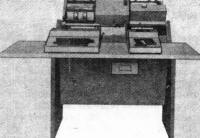 |
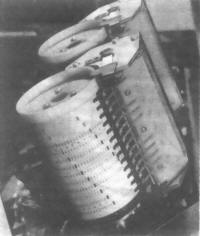 |
 |
| Typical perforator used with mainframes
and data processing systems |
Mechanical card reader |
Perforated card containing microfilm -
so-called aperture card. |
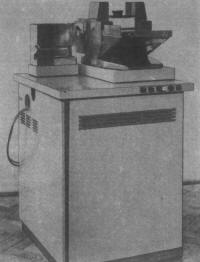 |
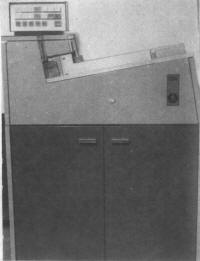 |
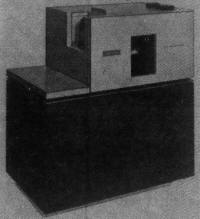 |
| Perforated card reader |
Another reader |
A stand-alone perforator |
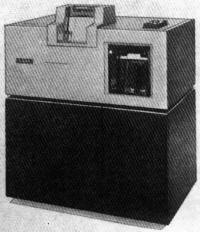 |
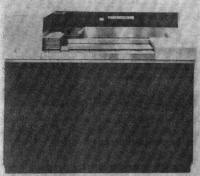 |
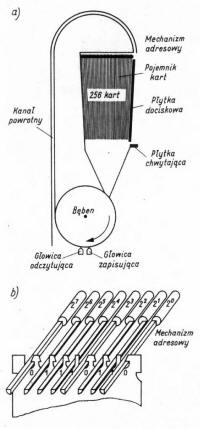 |
| Card reader |
Regnecentralen card reader |
And now something completely different - cards with
magnetic tracks - reading/writing and selection
mechanism. |
Most photos come from a book "Nowoczesne biuro - organizacja
i technika" (Modern office - organization and technology) from
early 1970s.
Processing without computer
Perforated cards could be processed without expensive computer-like device,
by processing in a series of separate devices. This type of data
processing was used in searching by elimination
or sorting/classification.
Click on a link to see photo of a device. First, data was
transferred to cards using perforator.
Next, it was checked in verifier to be
sure that it's correct. In this step cards could be placed in
labeler (for printed descriptions) or collator (to conactenate
with other card set). Ready set was used in
sorter, which sorted and classified cards. From sorter,
cards could be moved to reproducer (to make copies), result
perforator, to make temporary sums in helping card set, or
directly to tabulator, a large,
programmable (via electrical plug board)
device which performed simple actions on data such as summing,
computing basic values (sometimes with external calculator) or
completing a query. Results were printed out in a form of
tabulogramme. |










